Collection Donation to the City of Zagreb: The Dr Ivan Ribar and Cata Dujšin-Ribar Memorial Collection
Zagreb, Demetrova 3/II (Google maps)
Information and notice on: 01/4851-361, 01/4851-066
CURRENTLY CLOSED FOR VISITORS.
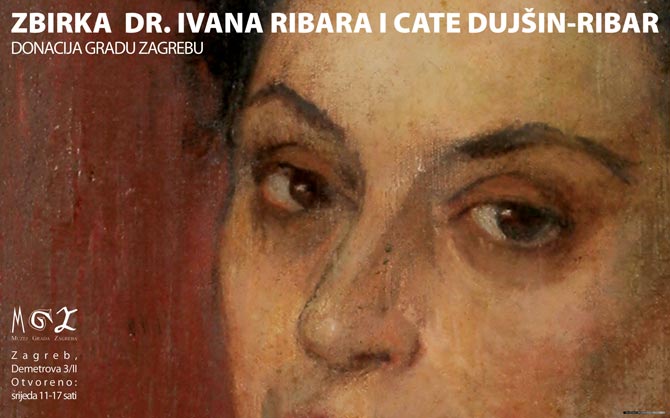
 The address Demetrova 3 brings together three exceptional personalities from our cultural and political life. They are Dubravko Dujšin – famed actor, director and theatre educator; Dr Ivan Ribar, leading politician before and particularly after World War II; and Cata Dujšin-Ribar – painter and poetess, a person whose life linked her with these two men.
The address Demetrova 3 brings together three exceptional personalities from our cultural and political life. They are Dubravko Dujšin – famed actor, director and theatre educator; Dr Ivan Ribar, leading politician before and particularly after World War II; and Cata Dujšin-Ribar – painter and poetess, a person whose life linked her with these two men.
Cata and Dubravko Dujšin moved to Demetrova St. in 1936, from the Actors’ House on Marulić Square. Here they lived together until Dubravko’s death on January 30, 1947. After Cata had married Dr Ivan Ribar in 1952, the flat in Demetrova 3 became his home as well.
Thanks to Cata Dujšin-Ribar the flat in Demetrova 3 became a museum collection. With the deed of gift signed on May 26, 1976, Cata Dujšin-Ribar gave the collection to the City of Zagreb, stipulating that a memorial collection should be set up in the flat, in which visitors would be able to acquire some insight into the life and work of three of the most notable people in Croatian culture, art and politics and look round the valuable collection of pictures, sculptures and various objects of the fine crafts.
The building at Demetrova 3 is of great cultural and historical, architectural and urban design value, and is protected by a preventive conservation order of the Regional Institute for the Protection of Monuments of Culture in Zagreb of 1969, and has the quality of cultural property.
The house was built on the old city ramparts in the middle of the 18th century, and the current form of the four-wing mansion with an interior courtyard was acquired with extensions in the 19th and 20th century. Up to the mid-19th century, the house consisted of a twostorey western wing on the rampart and a northern wing looking onto the street, alongside which were the stables. In the middle of the 19th century, a storey was added on to the street wing, together with an entrance passage and a Classicist staircase, as well as a wooden portico on the eastern and southern side of the courtyard. The second floor on the western and northern wings was added in 1926 after a design by the architect Ignjat Fischer, who had a studio in the house. Then the portico in the courtyard acquired stone pillars, and a well was made in the yard.
The flat of Cata Dujšin-Ribar is located on the second floor of the wing looking onto Tuškanac. This is a large four-roomed flat with an additional maid’s room, 128 square metres in total area.
The memorial space consist of the hall, Cata’s room, the sitting room, the bedroom and the room of Dr Ivan Ribar.
.jpg)
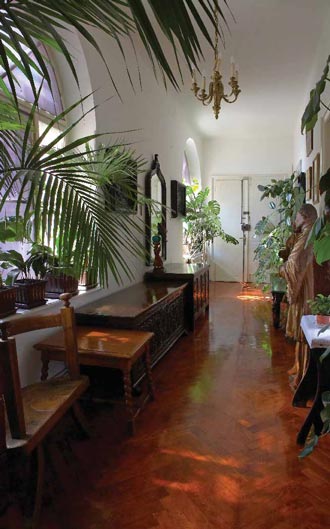
HALL
Packed with decorative plants (which Cata lovingly cultivated and that we have kept up to this day), the hall full of paintings and other works of art takes us into the collection. Cata’s own drawings and paintings are hung on the walls of the hall; there are also two reliefs that are copies of scenes from the Buvina door in Split Cathedral, a crystal Venetian mirror (second half of the 19th century), a mirror in a gilt, carved and perforated frame (18th century), a carved bench of the second half of the 19th century, two Baroque wooden sculptures of saints, 18th century, two carved Dalmatian chests of the 19th century, and a glazed display case with much valuable porcelain.
SITTING ROOM
The sitting room was a place for meeting and enjoying the company of the droves of artists, actors, writers and painters who would gather here. The sitting suite consists of a sofa (once the ottoman of Dubravko Dujšin), an armchair, a Chinese table of black lacquered wood with a brass top with engraved ornaments and dragons. Over the sofa is a mirror in a black wooden frame with rich silvered Rococo-style ornaments with prominent busts (second half of the 19th century); the curtain rails over the windows are in the same style. By the window there is a large dining table with eight chairs.
Left of the entry door there is an opulent Baroque tabernacle of the first half of the 18th century, and next to it is an extremely valuable painting, a Madonna and Child of the 15th century Italian master Vittore Crivelli, and a painting of Fair-Haired Madonna (oil on copper, Italy, early 16th century), as well as a plaster copy of a head from Šibenik Cathedral. Next to the tabernacle is a chair (Savonarola chair as it is called, composed of crossed strips of wood, with carved heraldic signs on the seat and the back).
On the other side of the door that leads to the bedroom is a carved chest on the front of which is a medallion with a bird. Over it Cata’s paintings are hung, and a prominent place is occupied by a portrait of her first husband Dubravko Dujšin (1935). The other walls too are full of Cata’s paintings; another leading place is occupied by a portrait of Sai Baba (1982), and over a chest of drawers there is a portrait of Dr Ivan Ribar (1948).
On the chest of drawers is Cata’s collection of painted plates (stoneware, from the second half of the 18th to the middle of the 19th century), a portrait of I. T. done by Ivan Meštrović, a photograph of Cata and her sister, and several vases. This room also contains a bust of Dubravko by Vanja Radauš and a bust of Cata by Grga Antunac (1956).
.jpg)
CATA'S ROOM
Cata’s own room was both her studio and a place for meeting her best friends. The walls of the room are hung with most of her paintings produced between 1919 and 1990; prominent among them is the Self-Portrait (1948) on an easel. Next to the easel, on a little round table, are her paints and palette. The room is furnished with valuable antique or reproduction furniture: a Baroque Venetian tabernacle with mirror and a richly articulated crenellation in the middle of which is a Venetian lion (18th century); a chest with two drawers, decorated with an inlaid strip meander (about 1800); a small chest of drawers that has one straight and two protuberant drawers, which is supported by two painted columns (Biedermeier, first half of the 19th century); a Biedermeier writing desk with black half-columns in the centre (first half of the 19th century). The writing desk holds a slender wooden figure of St Anthony (Dalmatia, 19th century) and Moses, a sculpture in wood of the 18th century.
.jpg)
This room was Cata’s studio and room for recollecting people she loved: the chest of drawers is full of photographs of her sister and brother, of Dubravko and dear friends of hers, and next to it, on the wooden pedestal, is a bronze portrait of Dr Ivan Ribar, the work of Kosta Angeli Radovani.
In this room is a fine collection of books with works from the area of visual and theatrical arts. Within the bookshelves, Cata set up a small display case with glazed doors in which she kept mementoes of her deeply grieved husband, Dubravko Dujšin. In it she put Dubravko’s bow-tie, his ties, photos with a dog and those from scenes of theatrical performances, Dubravko’s theatre jewellery and other personal items.
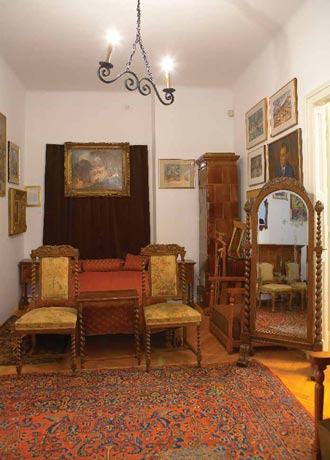 BEDROOM
BEDROOM
The bedroom is equipped with furniture of light brown polished wood in the spirit of the northern Renaissance (wardrobe, cupboard for linen, two bedside tables and a bed, a bench, a small table on twisted legs with two chairs and a matching large standing mirror).
In the room there is also a wooden chest fitted with embossed brass sheeting and decorated with reliefs, English work of the second half of the 19th century, a neo-Baroque footstool with lions’ heads, covered with leather and a little chair cum footstool with bent sides and an upholstered seat (first half of the 19th century).
On the walls many of Cata’s paintings are hung: one more portrait of Dubravko Dujšin (1927), Njegoš (1940), Lorca (1931), Flowers, Olive Trees, Widow....
ROOM OF DR IVAN RIBAR
The room of Dr Ivan Ribar was his study and the room in which he received his official and political guests. It contains a suite of brown veneered wood with some occasional carved plant decorations bought in Belgrade in 1947 and two Biedermeier chests of drawers.
In this room, Dr Ribar kept portraits of his two sons, who had been killed – Jurica (the work of Nikola Graovac) and of Ivo-Lola (the work of Cata Dujšin-Ribar of 1954) and of his first wife, Tonica (by Boris Pastuhov, 1931).
There are also the works of Jurica Ribar. On the wall over the Biedermeier chest of drawers, alongside the works of Jurica, are two portraits of the Ribar family estate (Marija Radočaj-Pintar and Ivan Pintar), painted by Vjekoslav Karas. On a pedestal alongside the bookshelf are a bust of Ivo Lola Ribar, the work of Toma Rosandić and a bust of Josip Broz Tito, the work of Antun Augustinčić.
BIOGRAPHIES
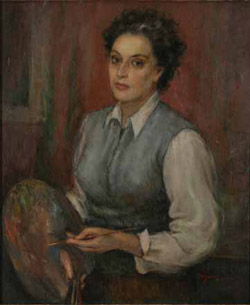 CATA DUJŠIN-RIBAR (Trogir, October 17, 1897 – Zagreb, September 8, 1994), painter and poet.
CATA DUJŠIN-RIBAR (Trogir, October 17, 1897 – Zagreb, September 8, 1994), painter and poet.
She spent her childhood in Kotor, where she attended three years of the Commercial Academy, and then in Zagreb studied painting at the Academy of Fine Arts (1917-1921); her teachers were F. Kovačević, O. Iveković, M. C. Crnčić; later she studied privately with the painter Vladimir Becić (1924-1925). She did further studies in Paris and London. At one time she worked as a restorer in the Gallery of Fine Arts, Split. She began her exhibition career in 1927. The mainstay of Cata’s painterly oeuvre consists of portraits and landscapes as well as views of her native Dalmatia. She was an accomplished poet as well, and published several collections of verses: Partings without Partings (1971), From the Stone Echo (1975) and Lyrics (1984). She married Dubravko Dujšin in 1920 and Dr Ivan Ribar in 1952.
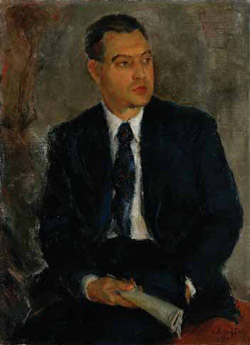 DUBRAVKO DUJŠIN (Zadar, September 12, 1894 – Zagreb, January 30, 1947), actor, director and theatre educator.
DUBRAVKO DUJŠIN (Zadar, September 12, 1894 – Zagreb, January 30, 1947), actor, director and theatre educator.
He completed Real High School in Split in 1911; for a short time he wrote for Supilo’s Novi list in Rijeka; in 1912 he enrolled in the course of the Commercial Academy in Milan. At the beginning of World War I he returned to Split and got a job as an accountant. He was mobilised and spent the war years of 1916-1918 in Boka Kotorska. In 1919 he arrived in Zagreb, and enrolled in the law course, as well as in the acting course in the State Acting School, taught by Branko Gavella. For the first time he appeared on the stage in 1920 in a minor role in Vojnović’s Lady with Sunflower. He finished acting school in 1922 and became a member of the acting ensemble of the Croatian National Theatre in Zagreb. During his fruitful acting career, he took many important roles, particularly in contemporary Croatian dramas. He also worked as a director in the CNT, and from 1937 to 1939 was head of drama in the Croatian National Theatre in Zagreb. He conveyed his acting experience to the younger generations working as a lecturer in the pre-war and post-war acting schools of the Croatian National Theatre.
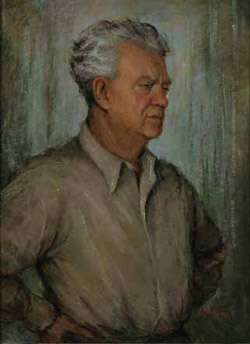 DR IVAN RIBAR (Vukmanić near Karlovac, January 21, 1881 – Zagreb, February 2, 1968), attorney and politician.
DR IVAN RIBAR (Vukmanić near Karlovac, January 21, 1881 – Zagreb, February 2, 1968), attorney and politician.
He studied law in Zagreb, Prague and Vienna and took a doctorate in Zagreb in 1904. In 1913 he became a deputy for the Croatian-Serbian Coalition in the Croatian Parliament, and was also a member of the joint Parliament in Budapest. He was one of the founders of the Democratic Party, and from 1920 to 1922 was president of the National Assembly of the Kingdom of the Serbs, Croats and Slovenes. In 1942 he joined the Partisans and became a member of the Communist Party of Yugoslavia. A respected politician, at the first session of AVNOJ (Anti-fascist Council of National Liberation of Yugoslavia) he was elected president of the Council’s executive committee, and after the war was president of the Presidium of the Interim National Assembly, as well as president of the National Assembly of the FPRY.
Vesna Vrabec
Related publications
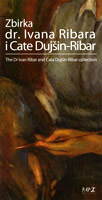 Vrabec, Vesna. The Dr Ivan Ribar and Cata Dujšin-Ribar Collection.
Vrabec, Vesna. The Dr Ivan Ribar and Cata Dujšin-Ribar Collection.
Zagreb : Zagreb City Museum, 2009
Related exhibitions
Vittore Crivelli: Virgin and Child, Zagreb City Museum, 2007

